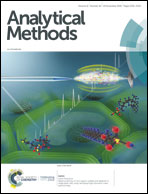Studies on the GFP-tagged receptor or β-arrestin2 in U2OS cells reveal two separate signaling pathways of purinergic P2Y1 receptors†
Abstract
The human purinergic P2Y1 receptor (P2Y1R) belongs to the family of G-protein coupled receptors (GPCRs). Two stable cell lines, hP2Y1R-tGFP/U2OS and hP2Y1R-β-AR2-tGFP/U2OS, were generated with steady expression of fluorescent tGFP tagged P2Y1R or tGFP tagged β-arrestin2. The High Content Screening (HCS) technique was used to investigate P2Y1R mediated signal transduction processes based on the distribution of fluorescent receptors or the β-arrestin2/receptor complex. All procedures including aggregation, endolysis and resensitization that were involved in the interaction between the P2Y1 receptor and its ligand can be visualized using the tGFP labeled receptor combined with HCS technology in this study. ADP activated P2Y1R to induce a distinguished pattern of fluorescent vesicle formation inside both cell types. These two cell lines produced different peak fluorescence signals when activated by ADP at 100 μM, and the time to form the maximal vesicles was detected as 15 and 20 min respectively. The EC50 values of the concentration–response curves of ADP induced formation of fluorescent vesicles were 35.7 nM and 71.8 nM respectively. The ADP effects could be blocked by a P2Y1R specific antagonist MRS2179. The P2Y1R are coupled to Gq protein to activate PLC first, PLC cleave PIP2 into IP3 and DAG. And then DAG and Ca2+ activate PKC pathway, and finally the phospholipase D initiates β-arrestin2 mediated signal pathway. It took 30 and 45 min to complete P2Y1R re-sensitization in these two constructs respectively. Our results demonstrated that P2Y1R triggered downstream responses not only via heterotrimeric Gq proteins but also through β-arrestin2.



 Please wait while we load your content...
Please wait while we load your content...